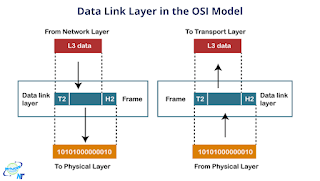Understanding the Data Link Layer in the OSI Model: Key Functions and Importance
Understanding the Data Link Layer in the OSI Model: Functions and Key Features
In the world of computer networking, the Data Link Layer plays a critical role in ensuring that data is transmitted smoothly and efficiently between devices. As the second layer of the OSI (Open Systems Interconnection) model, it is essential for enabling communication on both local and wide-area networks. This article will break down the key functions, responsibilities, and the importance of the Data Link Layer in a simplified and easy-to-understand manner, while also covering key SEO keywords related to this topic.
What is the Data Link Layer?
The Data Link Layer is the second layer in the OSI model, sitting just above the Physical Layer and below the Network Layer. This layer is responsible for transforming data packets from the Network Layer into frames that can be transmitted over the physical medium (such as cables or wireless connections). In essence, it facilitates reliable communication between two directly connected devices, such as two computers or network switches.
Key Functions of the Data Link Layer
The Data Link Layer performs several critical functions that ensure data is transmitted correctly across the network. Here are the primary responsibilities:
-
Framing
One of the most important tasks of the Data Link Layer is framing. This involves taking data packets from the Network Layer and encapsulating them into frames. A frame consists of a header (which contains control information) and the data itself. Once framed, the data can be sent bit-by-bit over the physical medium. -
Addressing
The Data Link Layer also provides hardware addressing. This is done through MAC (Media Access Control) addresses, which are unique identifiers assigned to each network interface card (NIC) at the time of manufacturing. MAC addresses ensure that data is delivered to the correct device on a local network. -
Error Detection and Correction
During data transmission, errors can occur, such as bit flips or lost signals. The Data Link Layer is responsible for detecting these errors and, in some cases, correcting them. If an error is detected, the layer will request a retransmission of the affected frame. This process ensures reliable communication between devices. -
Flow Control
The Data Link Layer ensures that data is transmitted at a speed that both devices can handle. Flow control mechanisms prevent faster devices from overwhelming slower ones. This is particularly useful in networks where devices may have varying processing capabilities. -
Synchronization
Both the sender and the receiver must be synchronized for the successful transmission of frames. The Data Link Layer handles this synchronization, ensuring that both devices are in sync before data is sent and received. -
Access Control
In a shared network environment, multiple devices may attempt to transmit data at the same time, leading to collisions. The Data Link Layer uses mechanisms like CSMA/CD (Carrier Sense Multiple Access with Collision Detection) in Ethernet networks to manage access to the shared medium and prevent data collisions.
Sub-layers of the Data Link Layer
The Data Link Layer is divided into two sub-layers, each serving different purposes:
-
Logical Link Control (LLC):
The LLC sub-layer is responsible for managing communication between devices on the network. It provides error control and flow control functions to ensure the data link operates smoothly. LLC interacts with the Network Layer to pass data up and down the OSI model. -
Media Access Control (MAC):
The MAC sub-layer is directly responsible for managing access to the physical transmission medium. It controls when devices can send data and handles the addressing using MAC addresses. In networks like Ethernet, the MAC sub-layer manages the frame formatting and collision avoidance mechanisms.
Common Protocols in the Data Link Layer
The Data Link Layer utilizes various protocols to manage data transmission effectively. Some of the most commonly used protocols include:
- Ethernet: A widely used protocol in local area networks (LANs) that defines how data is framed and transmitted over wired networks.
- Wi-Fi: A wireless protocol used for transmitting data over short distances, commonly found in home and office networks.
- PPP (Point-to-Point Protocol): Used to establish a direct connection between two network nodes over serial links.
- HDLC (High-Level Data Link Control): A bit-oriented protocol used in WAN (Wide Area Network) communications to frame and transmit data.
Why is the Data Link Layer Important?
The Data Link Layer is fundamental to network communication because it ensures reliable and error-free data transmission over a physical network. Without this layer, data would not be able to travel efficiently between devices on the same network. Additionally, it plays a crucial role in preventing collisions, detecting errors, and providing synchronization between devices, making it a core component of networking systems.
The Data Link Layer is an essential component of the OSI Model, responsible for ensuring that data is reliably and efficiently transferred over physical media. By performing tasks such as framing, addressing, error detection, and flow control, this layer ensures that communication between devices occurs without issues. Whether you're working with Ethernet, Wi-Fi, or any other network protocol, understanding the Data Link Layer’s role can help you troubleshoot network issues and improve the performance of your network.




